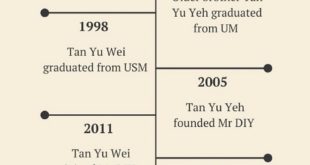Singaporeans are no strangers to Shopee. Even if they have never purchased anything from the e-commerce site, they are bound to have seen Shopee’s iconic orange ads, or heard its catchy marketing jingles.
There is a good reason for the large volume of customers on Shopee — you can buy a wide range of products off the platform, from household appliances, to fashion apparel, to food.
Besides purely shopping, Shopee also has various in-app entertainment options, such as live-streaming function ‘Shopee Live’, and interactive game show ‘Shopee Quiz’.
When Shopee first entered the market in 2015, Lazada was already the leading e-commerce platform in the region.
However, it quickly went from being a new entrant to becoming the most-visited e-commerce platform in Singapore by the second quarter of 2020.
According to Statista, Shopee saw approximately 14.1 million online visitors in the fourth quarter of 2020.
In 2017, Sea’s e-commerce registered a revenue of S$ 24.08 million. By 2019, it had ballooned nearly 50-fold to S$ 1.12 billion.
We take a look at the milestones of Shopee, and how it evolved from being a fledgling e-commerce platform to being one of the leading players in Southeast Asia (SEA).
2015 To 2016: The Early Days Of Shopee

Sea Limited — the parent company of Shopee — was founded in 2009, and it only jumped into e-commerce in 2015 with the launch of Shopee.
At that time, there were already many existing competitors in the region like Lazada, Qoo10, Taobao and Ezbuy.
However, the management took a leap of faith and launched Shopee in seven markets — Singapore, Indonesia, Malaysia, Thailand, Taiwan, Vietnam and the Philippines.
Shopee took a different strategy early on by launching as an app first to tap on SEA’s high mobile penetration rate.
According to a study by Google and Temasek, SEA’s average usage of mobile internet is the highest among regions (3.6 hours per person a day).
This is why Shopee immediately focused on optimising user experience and engagement through mobile from the beginning. Its mobile-first approach allows it to take advantage of the expected continued growth in mobile subscriber penetration.
2017: The Introduction Of Shopee Mall

In 2017, Shopee Mall was introduced across the region.
The portal is separate from the regular Shopee marketplace and provides access to thousands of products from over 200 top sellers and brands such as 3M, L’Oreal, Philips and Adidas.
According to a media statement, Shopee Mall was conceptualised due to the increasing need for brands to provide Singaporeans with a streamlined online shopping experience.
It also aids larger brands looking to pursue an omni-channel approach and reach out toe new customer bases.
The launch of Shopee Mall is a major move for us in establishing Shopee as an industry leader and a one-stop platform that caters to all our customers’ needs.
As we scale up our B2C efforts, customers can now shop conveniently from hundreds of leading brands.
– Zhou Junjie, Country Head of Shopee Singapore.
Shopee now has more than 11,000 Shopee Mall sellers in its seven markets.
2018: New Launches, BLACKPINK As Regional Ambassador

In 2018, Shopee launched the China Marketplace portal that offers shoppers easy access to products from Chinese merchants, without any shipping and agent fees in Singapore.
The new marketplace opened the doors to an expanded variety of affordable and quality products from China.
The platform also provides inroads for sellers in China to tap on Shopee’s thriving retail ecosystem in Singapore.

China Marketplace features millions of listings across categories such as Women’s Fashion, Home & Living, and Kids’ Fashion, giving shoppers access to top Chinese brands.
In May 2018, Shopee also launched its first Super Brand Day in Indonesia with P&G as its partner.

During its Super Brand Day, Shopee typically offers shoppers with exclusive deals, cash back options and promotions for selected brands. It has since organised 70 Super Brand Days around the region.
Shopee is also known for its ability to get wildly popular brand ambassadors onboard.
In 2018, Shopee announced Korean idol group BLACKPINK as its regional brand ambassador. The group was previously hailed by Billboard as the best-charting female Korean act in history.
The announcement was timed to coincide with Shopee’s 12.12 birthday sale, which saw a two-week promotional campaign.
That year, Shopee’s Gross Merchandise Value also hit US$ 10 billion with over 600 million transactions on the platform.
2019: New Sales Milestones, Cristiano Ronaldo Comes On Board
After it tapped on BLACKPINK as its first ever regional brand ambassador, Shopee brought onboard Portugese professional football player Cristiano Ronaldo.

Under the partnership, Ronaldo starred in Shopee’s 9.9 television commercial. It premiered in August 2019 and was aired in all Shopee markets.
The soccer star was seen dancing to a remix of the viral children’s song Baby Shark while swiping on Shopee’s mobile app in the company’s advertising campaign.
Fans in the region were also able to get up close and personal with the football star via a range of exclusive content available only on Shopee Live.
The 9.9 shopping event featuring Cristiano Ronaldo and Baby Shark saw three times more orders than the year before.
That year, Shopee saw 500 million total views on Shopee Live and over a billion plays of its in-app games.
During its 12.12 Birthday sale in December, Shopee sold 80 million items in a single day.
It also officially opened its new six-storey regional headquarters at Singapore Science Park.
Spanning 244,000 square feet, the office can accommodate 3,000 employees and is six times larger than its previous headquarters at Ascent Building,
2020: A Momentous Year Of Growth
With much of the retail sector hit hard due to Covid-19 restrictions and lockdowns in 2020, e-commerce saw an unprecedented boom.
As more and more merchants and consumers turned online, Shopee saw an 82 per cent increase in the number of users from the first to second quarter of 2020, gaining nearly an additional five million in average visitors.
The surge in the number of visits was also potentially driven by its strong promotional efforts through initiatives such as the 4.4 flash sale and Super Mart Month during the circuit breaker period.
Shopee’s revenue for Q4 2020 was US$ 842.2 million, up 178.3 per cent year-on-year.
This included US$ 627.6 million of marketplace revenue, up 175.4 per cent year-on-year; and US$ 214.6 million of product revenue, up 187.1 per cent year-on-year.

Furthermore, it was the third most downloaded app globally in the Shopping category for the full year of 2020.
Additionally, Shopee ranked first in YouGov’s “Best APAC Buzz Rankings 2020” and ranked eighth in YouGov’s “Best Global Brands 2020”.
It represents one of the only two e-commerce brands in YouGov’s top 10 global brand rankings.
What’s Next For Shopee?
With a young and large population of 650 million people, SEA is known to be the world’s fastest-growing internet region in recent years.
A joint study between Google and Temasek Holdings last year predicted that SEA’s digital economy will triple in size by 2025, reaching US$ 240 billion.
As a key driver of this economy, e-commerce is expected to be valued at US$ 102 billion in gross merchandise in the year 2025 as well.
This presents a hotbed of opportunities for Shopee. In 2020, the company continued to rank top in the Shopping category by active monthly users in Southeast Asia and in Taiwan.
The company is also moving towards other functions besides its marketplace features, which hints at possible network expansion.
For example, Shopee began extending loans to sellers through Sea’s payments business unit Sea Money in 2019.
Furthermore, Sea also won a digital banking license by the Monetary Authority of Singapore last year. This is likely to give Shopee more points of collaboration with its merchants.
These networks built by Shopee can be a virtuous cycle that could allow it to invest more in customer service and fulfilment, further attracting more customers.
Featured Image Credit: Inside Retail Asia



